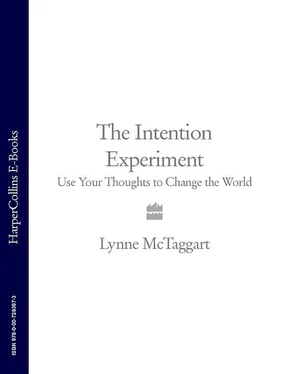1 ...6 7 8 10 11 12 ...25 Rosenbaum decided to carry out another experiment to attempt to isolate the property in the crystal’s essential nature that had enabled it to override such strong outside influences. He left the study’s design to his bright young graduate student, suggesting only that she create a computerized three-dimensional mathematical simulation of the experiment she had intended to carry out. In experiments of this nature on such tiny matter, physicists must rely on a computerized simulation to confirm mathematically the reactions they are witnessing experimentally.
Sai spent months developing the computer code and building her simulation. The plan was to find out a bit more about the salt’s magnetic capability, by applying two systems of disorder to the crystal chip: higher temperatures and a stronger magnetic field.
She prepared the sample by placing it in a little 2.4 x 4.8 cm copper holder, then wrapped two coils around the tiny crystal: one a gradiometer, to measure its magnetic susceptibility and the direction of spin of the individual atoms, and the other to cancel out any random flux affecting the atoms inside.
A connection attached to her PC would enable her to change the voltage, the magnetic field or the temperature, and would record any changes whenever she altered one of the variables by the tiniest degree.
She began lowering the temperature, a fraction of a kelvin (K) at a time, and then began applying a stronger magnetic field. To her amazement, the atoms kept aligning progressively. Then she tried applying heat, and discovered they again aligned. No matter what she did, in every instance the atoms ignored the outside interference. Although she and Tom had flushed out most of the compound’s magnetic component, of its own volition, as it were, it was turning into a larger and larger magnet.
That’s weird, she thought. Perhaps she should take more data, just to ensure they had encountered nothing strange in the system.
She repeated her experiment over six months until the early spring of 2002, when her computer simulation was finally complete. One evening, she mapped the results of the simulation on a graph, and then she superimposed the results from her actual experiment. It was as though she had drawn a single line. There on the computer screen was a perfect duplicate: the diagonal line formed from the computer simulation lay exactly over the diagonal line created from the results of the experiment itself. What she had witnessed in the little crystal was not an artefact, but something real that she had now reproduced in her computer simulation. She had even mapped out where the atoms should have been on the graph, had they been obeying the usual laws of physics. But there they were in a line: a law completely unto themselves.
She wrote Rosenbaum a guarded email late that evening: ‘I’ve got something interesting to show you in the morning.’ The following day, they examined her graph. There was no other possibility, they both realized; the atoms had been ignoring her and instead were controlled by the activity of their neighbours. No matter whether she blasted the crystal with a strong magnetic field or an increase in temperature, the atoms overrode this outside disturbance.
The only explanation was that the atoms in the sample crystal were internally organizing and behaving like one single giant atom. All the atoms, they realized with some alarm, must be entangled.
One of the strangest aspects of quantum physics is a feature called ‘non-locality’, also poetically referred to as ‘quantum entanglement’. The Danish physicist Niels Bohr discovered that once subatomic particles such as electrons or photons are in contact, they remain cognizant of and influenced by each other instantaneously over any distance forever, despite the absence of the usual things that physicists understand are responsible for influence, such as an exchange of force or energy. When entangled, the actions – for instance, the magnetic orientation – of one will always influence the other in the same or the opposite direction, no matter how far they are separated. Erwin Schrödinger, another one of the original architects of quantum theory, believed that the discovery of non-locality represented no less than quantum theory’s defining moment – its central property and premise.
The activity of entangled particles is analogous to a set of twins being separated at birth, but retaining identical interests and a telepathic connection forever. One lives in Colorado, and the other in London. Although they never meet again, both like the colour blue. Both take a job in engineering. Both like to ski; in fact when one falls down and breaks his right leg at Vale, his twin breaks his right leg at precisely that moment, even though he is 4000 miles away, sipping a latte at Starbucks. 4Albert Einstein refused to accept non-locality, referring to it disparagingly as ‘ spukhafte Fernwirkungen ’ or ‘spooky action at a distance’. This type of instantaneous connection would require information travelling faster than the speed of light, he argued through a famous thought experiment, which would violate his own special relativity theory. 5Since the formulation of Einstein’s theory, the speed of light (299,792,458 metres per second) has been used as the absolute limiting factor on how quickly one thing can affect something else. Things are not supposed to be able to affect other things faster than the time it would take the first thing to travel to the second thing at the speed of light.
Nevertheless, modern physicists, such as Alain Aspect and his colleagues in Paris, have demonstrated decisively that the speed of light is not an absolute outer boundary in the subatomic world. Aspect’s experiment, which concerned two photons fired off from a single atom, showed that the measurement of one photon instantaneously affected the position of the second photon 6so that it has the same or opposite spin or position (as IBM physicist Charles H. Bennett once put it, ‘opposite luck’). 7The two photons continued to talk to each other and whatever happened to one was identical to, or the very opposite of, what happened to the other. Today, even the most conservative physicists accept non-locality as a strange feature of subatomic reality. 8
Most quantum experiments incorporate some test of Bell’s Inequality. This famous experiment in quantum physics was carried out by John Bell, an Irish physicist who developed a practical means to test how quantum particles really behaved. 9This simple test required that you get two quantum particles that had once been in contact, separate them and then take measurements of the two. It is analogous to a couple named Daphne and Ted who have once been together but are now separated. Daphne can choose one of two possible directions to go in and so can Ted. According to our commonsense view of reality, Daphne’s choice should be utterly independent of Ted’s.
When Bell carried out his experiment, the expectation was that one of the measurements would be larger than the other – a demonstration of ‘inequality’. However, a comparison of the measurements showed that both were the same and so his inequality was ‘violated’. Some invisible wire appeared to be connecting these quantum particles across space, to make them follow each other. Ever since, physicists have understood that when a violation of Bell’s Inequality occurs, it means that two things are entangled.
Bell’s Inequality has enormous implications for our understanding of the universe. By accepting non-locality as a natural facet of nature we are acknowledging that two of the bedrocks on which our world view rests are wrong: that influence only occurs over time and distance, and that particles like Daphne and Ted, and indeed the things that are made up of particles, only exist independently of each other.
Читать дальше











